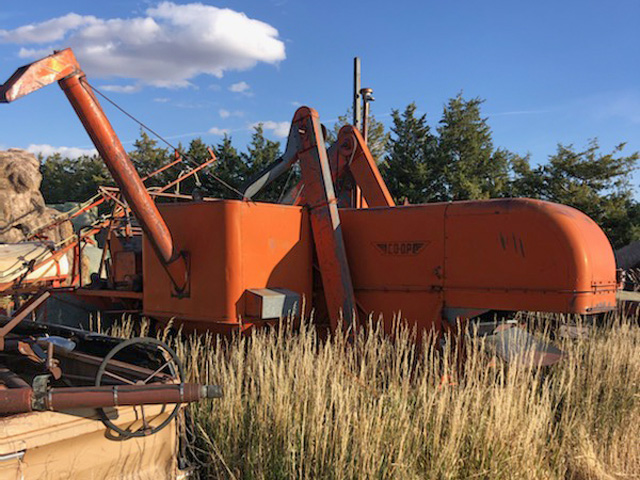Russ' Vintage Iron
Readers Share More Stories About Vintage Combines
The past couple of months, we have had quite a discussion in this column about some of the lesser-known combine manufacturers with many responses from readers about a wide variety of subjects. Today, we look at some more stories.
**
"At one time, Oliver made just about everything in the way of farm equipment. The tractors were popular around here, especially among the potato farmers.
The attached picture is the first of a combine I ever saw on tracks. The first grain cart I ever saw was called a 'rice buggy' and was being used to move grain away from rice combines."
-- Howard Myers
Lawrenceville, New Jersey
**
"I enjoy reading your articles on the DTN.
The last couple have talked about old combines and mentioned Cockshutt combines. This is a picture of a Co-op combine that was made by Cockshutt, just like the Co-op tractors were.
It used a six-cylinder, flat head Chrysler engine. I have two of these old combines but neither of them were ever used by my dad, just ones I've moved on the place.
There is another old Co-op combine sitting on a neighbor's yard that is the next model bigger. There used to be a Co-op machinery dealer in the local town of Sidney (Neb.) and because of this there were a few combines and quite a few tractors in the area.
My dad bought a new E5 diesel tractor in 1952 from this dealer. I still have that tractor (original rubber on the rear, always shedded) along with close to two dozen other Co-op and Cockshutt tractors I've picked up over the years.
P[L1] D[0x0] M[300x250] OOP[F] ADUNIT[] T[]
My goal was to have one of each model restored someday. That day will probably never come since I only have one restored, but it's still a dream.
In your article you mentioned the Cockshutt 30, 40 and 50 as well as the Co-op E3, E4 and E5. They also made a cute little 20 and E2 with a four-cylinder, flat head Continental engine instead of the Buda engine. I have been lucky to find both a 20 and E2 for my collection.
The rarest Cockshutt I have is 30 Diesel model. I also have a Co-op sickle mower along with a rake and plow, made by Cockshutt.
Keep up the great articles!"
-- Phil Narjes
Lodgepole, Nebraska
**
"I just read your DTN story. Nobody mentioned the few Allis Chalmers self-propelled combines. I had a neighbor who had one of those combines.
I don't think many were made or sold as Allis soon went with Baldwin or Gleaner on combines.
Also, Case made a few combines up until the late 1960s. My father had a model 600 and a neighbor had an 800.
Somewhere in the early 1950's (I am not certain) Minneapolis Moline (MM) may have put out a few combines. This may be worth a search on that one."
-- Tom Moore
**
Thanks to Howard, Phil and Tom for the interesting stories about vintage combines.
Not that I know everything when it comes to vintage farm machinery, but I did not even know that Cockshutt/Co-op even made combines until these stories started coming in. I did find some interesting history regarding Cockshutt combines at http://cockshutt.com/…:
"Cockshutt Self-Propelled Harvester Combines also made a good name for themselves. First with variable speed drives and bomber-style tires, Cockshutt combines put a cleaner sample in the grain tank, with less loss over the straw walkers."
As with Cockshutt/Co-op, again I did not know that Allis Chalmers and Case manufactured self-propelled combines as well. According to the All-Crop harvester Wikipedia page (https://en.wikipedia.org/…), Allis made combines from the mid-1930s to the early 1960s.
Pull-type combines included Model All-Crop 40, 60, 60A, 66, 72 and 90. Self-propelled models included the All-Crop SP100 and the Super SP100.
The All-Crop SP100 was made from 1953 to 1957 with 4,500 units built. The All-Crop Super SP100 was only built in 1958 with just 1,000 units manufactured. This model was replaced by the Gleaner combine when Allis Chalmers acquired the Gleaner Harvester Corp.
There was no Wiki page for the Gleaner Harvester Corp., which is too bad. I would have liked to know more about that company and the story of its merger into Allis-Chalmers.
When I Googled "vintage Case combines," it pulled up some photos and some videos of Case combines working in the fields but no Wiki page. It also pulled a website of 100 years of harvesting from Case IH but everything on that site was IH related, which would probably rub some Case fans wrong.
And when I searched Minneapolis Moline combines, it did pull up some images and videos but little else. The pages did show a few photos of a rare, red MM combine.
I want to thank everyone the last couple of months who sent me their stories of various vintage combines. I know I learned much about vintage iron combines!
Russ Quinn can be reached at russ.quinn@dtn.com
Follow him on Twitter at @RussQuinnDTN
(c) Copyright 2020 DTN, LLC. All rights reserved.



